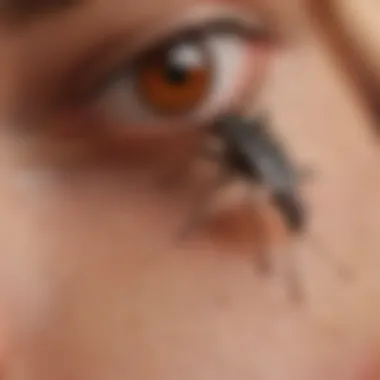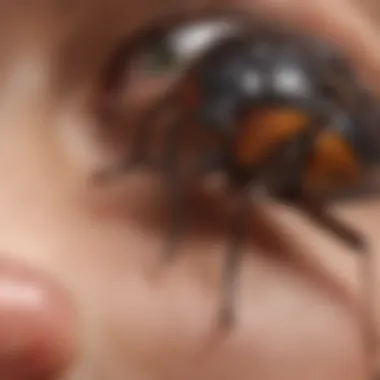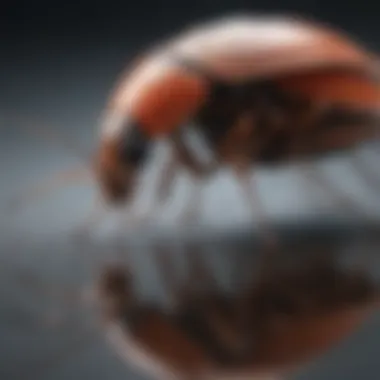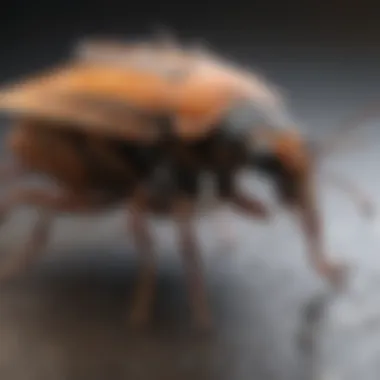Comprehensive Strategies to Eliminate Kissing Bug Infestation


Preventive Pest Control Strategies
When it comes to effective pest management, employing preventive measures is key in maintaining a pest-free environment. Housewives and house owners can start by focusing on safeguarding their household against kissing bugs through various strategies. One essential aspect is protecting the house exterior. This involves meticulous tips for sealing cracks found in walls, windows, and doors. Additionally, clearing debris around the property is crucial as these areas can provide hiding spots for pests. Ensuring that pests do not have easy access into the house is also vital to prevent infestations.
In parallel, maintaining the yard plays a significant role in pest control. Engaging in essential yard care routines such as regular mowing, trimming, and removing stagnant water helps in keeping the yard pest-free. Implementing methods like keeping vegetation trimmed and reducing excess clutter can deter pests from congregating near the house. On the indoor front, advocating for cleanliness is imperative. House owners should follow expert cleaning tips and techniques to eliminate potential hiding spots for bugs. Keeping a pest-resistant indoor environment through regular cleaning routines can reduce the likelihood of infestations.
Furthermore, proper garbage disposal is paramount in deterring pests from infiltrating the living space. Efficient waste disposal methods should be followed to avoid attracting insects and rodents to the house. Emphasizing the importance of segregating and sealing waste containers can significantly reduce the risk of pest infestations. Apart from these fundamental strategies, implementing innovative pest prevention mechanisms can provide an additional layer of protection for the household.
Understanding Kissing Bugs
Kissing bugs, also known as triatomine bugs, are a significant concern due to their link to Chagas disease. Understanding these insects is crucial in combating infestations effectively. By identifying their physical characteristics, behavior patterns, and preferred habitats, homeowners can take proactive measures to eliminate them. This section delves into the specifics of kissing bugs, shedding light on their biology and habits.
Identifying Kissing Bugs
Physical Characteristics
Identifying kissing bugs by their physical characteristics is key to addressing infestations. These insects are typically dark-colored, winged creatures ranging from as small as half an inch to over an inch in length. Their most distinct feature is their cone-shaped head with a long, slender beak used for blood-feeding. This anatomical adaptation makes them efficient vectors for disease transmission. While their appearance may vary slightly based on species, these common features remain consistent.
Behavior Patterns
Understanding the behavior patterns of kissing bugs aids in targeted control strategies. These nocturnal insects are attracted to sources of warmth and carbon dioxide, making human dwellings ideal habitats. They feed on blood by biting sleeping hosts on exposed areas. Their secretive habits, including hiding in cracks and crevices during the day, make them challenging to detect. By grasping their nocturnal nature and feeding preferences, homeowners can customize prevention methods accordingly.
Preferred Habitats
Kissing bugs prefer residing in areas close to their blood meal sources, such as mammals and birds. They seek out cozy spaces near sleeping areas, including cracks in walls, furniture, and roofing. These insects thrive in warm, humid climates, favoring regions with moderate temperatures year-round. Recognizing their affinity for specific environments empowers individuals to fortify their homes effectively and reduce potential infestation risks.
Health Risks Posed by Kissing Bugs
Chagas Disease Transmission
The transmission of Chagas disease by kissing bugs poses a significant health risk. These insects carry the Trypanosoma cruzi parasite in their feces, which can enter the bloodstream through their bite wound. Once inside the body, the parasite can lead to severe complications, including heart and digestive system issues. Preventing exposure to kissing bugs and addressing infestations promptly are vital in preventing Chagas disease transmission.


Symptoms and Complications
Symptoms of Chagas disease vary from mild to severe and may include swelling at the bite site, fever, fatigue, and body aches. If left untreated, the disease can progress to chronic stages, causing heart rhythm abnormalities and digestive problems. Early diagnosis and management are crucial in mitigating the long-term effects of Chagas disease. Recognizing the symptoms and seeking medical attention promptly are essential steps in safeguarding one's health.
Preventative Measures
Preventative measures play a crucial role in the comprehensive strategy to eliminate kissing bug infestation. By implementing preventative measures, individuals can significantly reduce the risk of infestation and protect their homes from these pests. These measures serve as a proactive approach to pest control, focusing on addressing potential entry points and deterrents for kissing bugs. In this article, we emphasize the importance of early intervention through preventative strategies, highlighting the long-term benefits they offer in maintaining a pest-free environment.
Securing Your Home
Sealing Cracks and Gaps
Sealing cracks and gaps in your home is a fundamental aspect of preventing kissing bug infestation. These openings provide easy access for pests, including kissing bugs, making it essential to seal them effectively. By sealing cracks and gaps in walls, windows, doors, and foundations, homeowners can create a barrier that inhibits pest entry. The key characteristic of sealing cracks and gaps is its effectiveness in blocking potential entry points, thereby reducing the chances of infestation. While this method is a popular choice for pest control, ensuring thoroughness in sealing is crucial for optimal results. The unique feature of sealing cracks and gaps lies in its ability to eliminate hidden entryways for pests, adding an additional layer of protection against kissing bugs in this article.
Screening Windows and Doors
Screening windows and doors is another vital component of securing your home against kissing bugs. Installing screens on windows and doors acts as a physical barrier that prevents pests from entering indoor spaces. The key characteristic of screening is its ability to allow air circulation while keeping pests out, contributing to a healthier indoor environment. This method is a popular choice for homeowners due to its efficiency in blocking insect entry. The unique feature of screening windows and doors is its versatility, offering protection against a variety of pests beyond kissing bugs. However, regular maintenance and inspection are necessary to ensure the screens remain intact and functional for continued pest prevention in this article.
Maintaining Cleanliness
Maintaining cleanliness in and around your home is essential for effective kissing bug prevention. Pests are attracted to clutter, food residues, and standing water, making cleanliness a critical factor in deterring infestations. By regularly cleaning and decluttering living spaces, homeowners can eliminate potential hiding spots and food sources for kissing bugs. The key characteristic of maintaining cleanliness is its ability to disrupt the pest's living conditions, reducing their attraction to the area. While this method is a beneficial choice for sustainable pest control, diligence in sanitation practices is crucial for long-term success. The unique feature of maintaining cleanliness is its role in promoting overall well-being and hygiene, benefiting not only pest prevention but also the general health of household residents in this article.
Outdoor Area Maintenance
Yard Cleanup
Yard cleanup plays a significant role in reducing the risk of kissing bug infestation in outdoor spaces. By removing debris, leaf piles, and overgrown vegetation, homeowners can eliminate potential hiding spots for pests. The key characteristic of yard cleanup is its ability to create an inhospitable environment for pests, reducing their presence in the vicinity. This method is a popular choice for outdoor pest management due to its effectiveness in minimizing pest habitats. The unique feature of yard cleanup is its impact on overall curb appeal and landscaping, enhancing the aesthetic value of the property while simultaneously deterring kissing bugs and other pests.
Reducing Attractants
Reducing attractants in outdoor areas is crucial for minimizing the risk of kissing bug infestation. Pests are drawn to sources of food, water, and shelter, making it necessary to eliminate attractants in the yard. By fixing leaks, sealing trash cans, and storing firewood away from the house, homeowners can create an unwelcoming environment for pests. The key characteristic of reducing attractants is its ability to limit the factors that attract kissing bugs to the property, decreasing the likelihood of infestation. This method is a beneficial choice for long-term pest prevention, focusing on addressing root causes rather than just symptoms. The unique feature of reducing attractants lies in its sustainable approach to pest management, promoting a harmonious coexistence between homeowners and their outdoor environment in this article.


Natural Remedies and DIY Solutions
Natural remedies and do-it-yourself (DIY) solutions play a crucial role in addressing kissing bug infestations. These innovative approaches not only offer environmentally friendly alternatives but also empower homeowners to take control of their pest management. By incorporating natural remedies, individuals can mitigate the risks associated with chemical intervention while effectively combating these nuisance insects. An emphasis on non-toxic solutions underscores a safer and more sustainable way to address kissing bug infestations.
Essential Oils and Repellents
Lavender Oil
Lavender oil stands out as a remarkable natural solution in combating kissing bugs. Its distinct fragrance serves as a potent repellent, deterring these pests from invading living spaces. The calming scent of lavender not only masks human odors that attract kissing bugs but also disrupts their trail pheromones, making it harder for them to locate potential hosts. Furthermore, lavender oil possesses antimicrobial properties, which can enhance the overall hygiene of treated areas. The versatility of lavender oil in combating kissing bugs makes it a popular choice for those seeking natural and effective remedies.
Neem Oil
Neem oil offers a multifaceted approach to tackling kissing bug infestations. Known for its insecticidal properties, neem oil serves as a potent deterrent against a variety of pests, including kissing bugs. The compounds in neem oil disrupt the growth and development of these insects, reducing their population over time. Additionally, neem oil acts as a repellent, making treated areas less appealing to kissing bugs. Its eco-friendly nature and minimal impact on beneficial organisms make neem oil a preferred choice for environmentally conscious individuals looking to address pest issues.
Citronella
Citronella serves as an effective natural repellent against kissing bugs due to its strong and distinctive aroma. This fragrant oil masks human scents, making it harder for kissing bugs to locate their prey. Citronella's repelling action not only discourages these pests from entering homes but also creates a barrier that can protect outdoor living spaces. Its non-toxic nature and widespread availability make citronella a practical choice for individuals seeking natural solutions to kissing bug infestations.
Homemade Traps
Sugar-Borax Trap
The sugar-borax trap offers a cost-effective and efficient method for trapping and exterminating kissing bugs. By combining sugar to attract the insects and borax to eliminate them, this trap exploits the pests' feeding behavior to ultimately eradicate them. Once ingested, borax affects the insects' digestive system, leading to their demise. The simplicity and effectiveness of the sugar-borax trap make it a popular DIY solution for homeowners looking to control kissing bug populations without resorting to harsh chemicals.
Petroleum Jelly Barrier
Creating a petroleum jelly barrier serves as a practical approach to prevent kissing bugs from accessing certain areas of the home. By applying a thick layer of petroleum jelly around entry points such as windows and doors, homeowners can block the insects' path and limit their intrusion. The sticky texture of petroleum jelly traps and immobilizes kissing bugs, preventing them from breaching indoor spaces. This barrier method is a non-toxic and easy-to-implement solution that provides a physical deterrent against these unwanted pests.
Professional Extermination Services
When facing a daunting kissing bug infestation, turning to professional extermination services is a crucial step in effectively tackling the problem. These services offer specialized expertise and tools that are essential in handling such pests. By entrusting the eradication process to certified pest control experts, homeowners can benefit from comprehensive solutions tailored to their specific infestation levels and property layouts. Professional extermination services not only address current infestations but also implement preventative measures to deter future occurrences. The advanced knowledge of these experts plays a pivotal role in ensuring a thorough and lasting eradication outcome.


Hiring Certified Pest Control Experts
Inspection and Assessment
In the realm of kissing bug infestation management, the inspection and assessment stage is fundamental. This process involves a meticulous examination of the property to identify infestation severity, potential entry points, and conducive conditions for kissing bugs. The detailed findings from this assessment inform the development of a targeted eradication plan, ensuring efficiency and effectiveness in eliminating the pests. Inspection and assessment serve as the foundation for tailored solutions that prioritize long-term pest prevention and management.
Treatment Options
Exploring various treatment options is a key aspect of professional extermination services for kissing bug infestations. Pest control experts utilize a range of methods, such as chemical treatments, biological controls, and eco-friendly solutions, to address infestations effectively. Each treatment option is carefully selected based on factors like infestation extent, property size, and environmental considerations to ensure maximum impact with minimal disruption. By offering diverse treatment approaches, certified professionals cater to the unique needs and preferences of homeowners, enhancing the overall eradication process.
Follow-Up Maintenance
Sustaining a pest-free environment after initial treatment is where follow-up maintenance comes into play. This phase involves regular inspections, monitoring, and re-evaluation to prevent re-infestation and address any emerging issues promptly. Follow-up maintenance services not only reinforce the effectiveness of prior treatments but also serve as a proactive measure against potential recurrences. By engaging in consistent follow-up maintenance, homeowners can enjoy prolonged protection against kissing bug infestations and maintain a secure living space for their families.
Long-Term Management Strategies
Effective long-term management strategies play a pivotal role in eradicating and preventing kissing bug infestation. By implementing a proactive approach towards pest control, homeowners can effectively safeguard their homes from these invasive insects. Long-term strategies offer a sustainable solution that not only eliminates existing infestations but also prevents future reoccurrences. Consistency and diligence in following these strategies are essential to maintain a bug-free environment.
Regular Inspections
Monitoring Infestation Levels
Monitoring infestation levels is a crucial aspect of long-term management strategies for kissing bug infestation. By regularly assessing the extent of infestation, homeowners can gauge the effectiveness of their pest control measures. Timely identification of infestation levels allows for prompt action to be taken, minimizing the risk of widespread infestation. Tracking and documenting infestation data provide valuable insights into the efficacy of implemented control measures.
Implementing Preventative Measures
Implementing preventative measures is key to sustainable pest control efforts. By addressing potential entry points and conducive conditions for kissing bugs, homeowners can create an inhospitable environment for these pests. Regularly inspecting and fortifying structural vulnerabilities such as cracks and gaps in walls, screens on windows and doors, and maintaining cleanliness reduces the risk of infestation. Preventative measures serve as a proactive defense mechanism against kissing bugs, ensuring long-term protection for households.
Educational Outreach
Community Awareness Programs
Community awareness programs play a crucial role in disseminating information about kissing bug infestation and prevention methods. By engaging with local communities, these programs raise awareness about the risks posed by kissing bugs and educate individuals on best practices for prevention. Through workshops, seminars, and educational materials, community awareness programs empower residents to take proactive measures in safeguarding their homes against these pests.
Sharing Information
Sharing information is vital in fostering a collective effort towards combatting kissing bug infestation. By exchanging knowledge and experiences related to pest control, homeowners can benefit from insights and strategies that have proven effective in pest management. Platforms such as online forums, social media groups, and neighborhood meetings offer avenues for sharing information and learning from others' experiences. Collaborative information sharing contributes to a mutual support system among homeowners facing similar pest control challenges.



